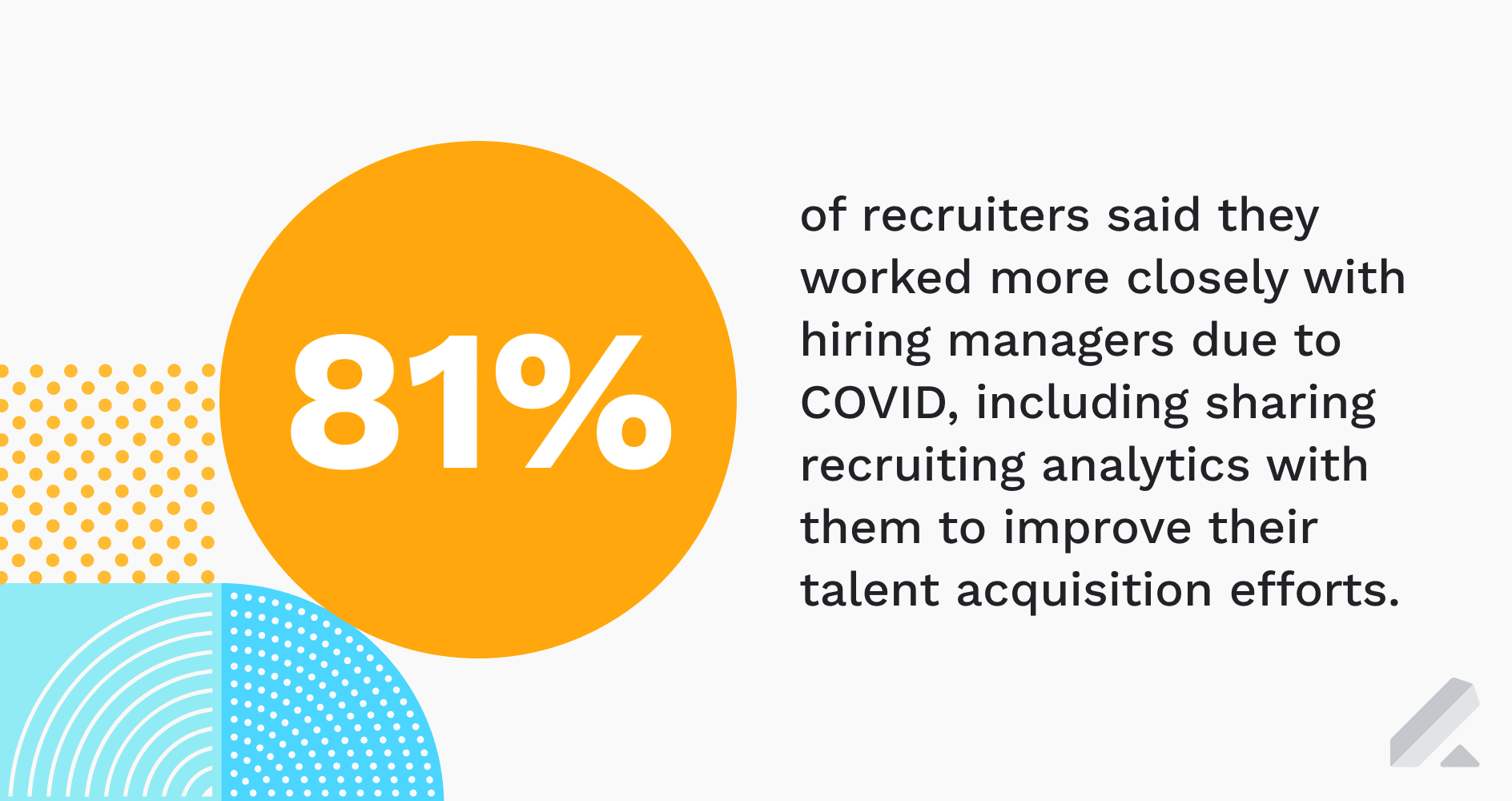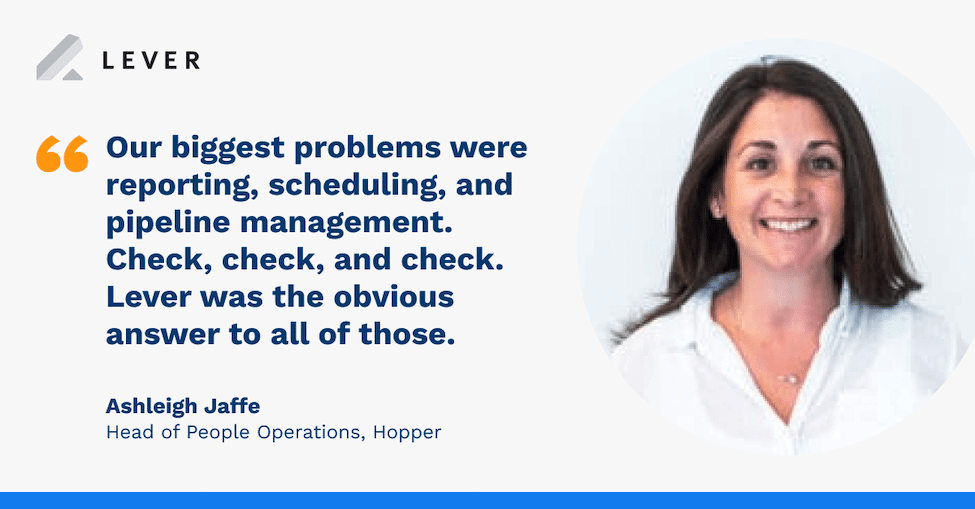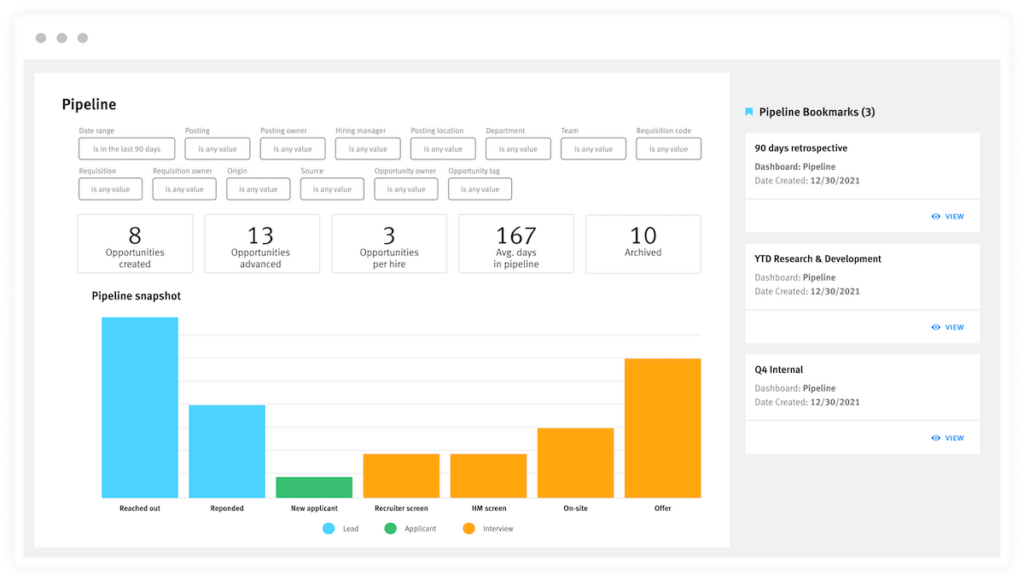Marketing, sales, and product (among other teams) collect and analyze data to execute and excel daily. Talent acquisition must do the same with their recruitment analytics.
There’s no shortage of recruiting data you can leverage to enhance your TA strategy.
The key to making the most of recruitment analytics for your full-cycle recruiting strategy is to know which data points and metrics matter most. This knowledge can help you and your talent team continually improve and enhance your hiring efforts.

Recruitment analytics: How insights into your hiring process and performance can help you grow
Use recruitment analytics and related, actionable insights to improve their recruiting team’s efforts. That’s how modern TA teams enhance their candidate sourcing and engagement efforts and boost conversions.
Recruitment analytics consists of both historic data and real-time data from your talent acquisition strategy. More specifically, it encompasses three main types of insights:
- Candidate experience: Qualitative feedback and numeric ratings regarding the recruitment experience of prospects you engage and interview for open roles has become increasingly vital for talent teams to collect.
- Diversity, equity, and inclusion (DEI): No DEI initiative today can succeed with data. The top diversity recruiting strategies use candidate sourcing, engagement, and offer insights to ensure they help build a diverse workforce.
- Core recruiting metrics: Time to fill, time to hire, cost per hire: Several key metrics tied to your recruiting process that can help each TA team member refine their day-to-day work and enhance their productivity.
Traditional applicant tracking systems offer some useful features for talent teams.
For instance, old-school ATS solutions help TA specialists write job descriptions, post job listings universally, and store most info tied to passive and active candidates.
But many older ATS lack built-in, easy-to-use analytics. That means TA team members must use disparate tools to evaluate their performance.
That’s where complete talent acquisition suites with out-of-the-box analytics can help.
Many orgs are ditching their legacy ATS and moving to platforms like LeverTRM. That’s because they can tap into our native analytics that offers rich, dynamic dashboards.
Consider Lever customer Hopper:
- Its talent team’s old ATS deterred it from assessing pipeline progress. For instance, it couldn’t easily see how recruiters moved candidates in the funnel. Moreover, they couldn’t quickly share relevant TA insights with leadership.
- So, Hopper moved to LeverTRM. Why? Because it has core ATS functionality, powerful candidate relationship management (CRM) capabilities, and robust analytics.
- The recruitment analytics provided in LeverTRM empowers Hopper’s recruiters to see “simple” data points it couldn’t previously. For instance, they can now see which job boards and social media channels lead to the highest-quality prospects.
“Our biggest problems were reporting, scheduling, and pipeline management,” said Hopper VP of People Ops Ashleigh Jaffe. “Lever was the obvious answer to all of those.”

How you can develop a proactive talent acquisition strategy with help from recruitment analytics
Secure a modern, advanced, and intuitive recruiting and hiring solution everyone on your talent team can use with ease. That’s the first (and most critical) step you must take to leverage your recruitment analytics and improve your TA strategy.
Here’s how Lever customers use the actionable insights offered in our ATS + CRM.
Start each day with an overview of upcoming tasks and candidate updates
Data drill-downs are essential. This practice will help you advance your talent analytics maturity over time. But it’s worth starting each day with a high-level view of your performance and progress before diving deep into your TA insights.
This can help your recruiters plan their tasks and comms for the day and week ahead.
LeverTRM users get this at-a-glance view in our Overview dashboard. In addition, Visual Insights provides a high-level snapshot of active listings, offer acceptance rates, opps hired and advanced in the funnel, and other crucial data points.
Recruiters with Lever can filter these dashboards by date range, posting and requisition owner, and team to get a more granular view of their data.
Talent specialists can even share a custom-filtered dashboard with colleagues and business leaders to ensure relevant stakeholders remain updated on hiring trends.
From here, dig down into other detailed, dynamically updated dashboards
The Overview dashboard is just that: an overview. Recruiters, talent leaders, and other hiring team members who want more in-depth insights into TA activities and recent performance can use our other helpful dashboards.
For instance, LeverTRM users turn to our many recruiting dashboards to assess:
- Interview processes and updates: The rate of scheduled-interview completions, how long it takes interview panelists to share feedback, the percent of positive and negative candidate scores
- Nurture campaign effectiveness: How many opps receive and reply to nurture emails, the nurture reply rate how many candidates who receive emails are moved to interviews and are hired
- General recruiter ops info: Details regarding open postings that recruiters ‘follow’ (e.g., posting hiring manager, days since publication) and offers (e.g., how many have been sent/are awaiting reply)
- EEO/DEI survey results: The overall diversity of one’s pipeline, at what stage(s) diverse job seekers are archived most often, archive reasons, a breakdown of prospects by diversity groups
Many dashboards offer eye-opening insights. The point is a regular analysis of these distinct facets of your TA efforts is now vital to improving key metrics.
[Download our Visual Insights eBook to learn more.]

Use past data to inform future decision-making and evolve your hiring
Data visualizations and insights won’t help if you don’t factor them into your daily decision-making. However, recruitment analytics can provide answers to questions that previously proved difficult (or impossible) to explain and resolve.
Lever customers use Visual Insights to make critical daily decisions. Notably, they:
- Learn the efficacy of sources and source origins based on quality-of-hire data
- Discover what causes bottlenecks in one or more of their interview stages
- Create plans to address these bottlenecks to speed up their recruiting process
- Evaluate high-performing nurtures so they can refine poor-performing nurtures
How you use your recruitment analytics and related insights depends on many factors.
But what’s clear is your best bet for building a data-driven hiring model is to get a holistic view of all data and make it accessible to and actionable to your whole TA team.
Your HR team uses data to boost employee retention rates and satisfaction levels. However, it would be best if you used your recruitment analytics to attract better and build relationships with top talent. Do that, and your TA metrics will improve across the board.
Download our data-driven recruiting eBook today. Learn how Lever customers use our recruitment analytics to elevate their TA programs and scale their hiring efforts.



